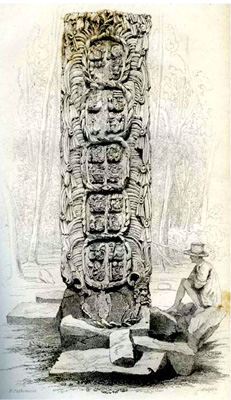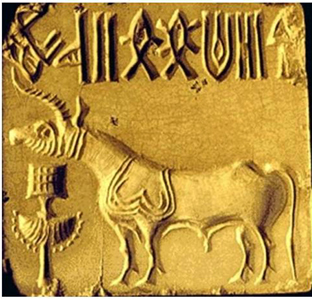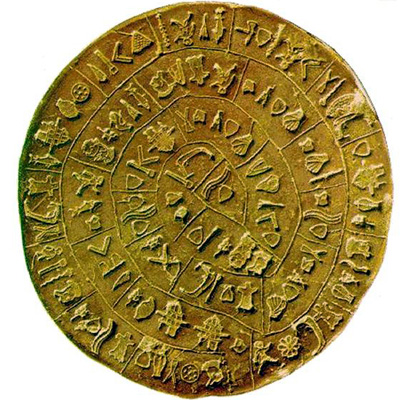Lost Languages
The Enigma of the World’s Undeciphered Scripts
Andrew Robinson
“Robinson’s enthusiasm for the subject is so infectious that
you might find yourself trying to crack Etruscan in your spare time.”
![]() —Archaeology
—Archaeology

Mayan glyphs.
It is hard to pin down what is so intrinsically fascinating
about the scripts of long vanished civilizations. Hidden in them seems
to be the key to exotic lost civilizations. Or perhaps like a cryptogram
in an Edgar Allen Poe story, they provide the clue to a fabulous treasure
like King Solomon's. This century has seen the decipherment of two major
scripts: the Mayan glyphs and the "Linear B" associated with
the Minoans of Crete. Yuri Knorosov's decipherment of the Mayan script
revealed a world of dynastic intrigue and conquest and a vibrant civilization
regulated by ritual based on complex astronomical calculations. Michael
Ventris’ decipherment of the Linear B tablets, while an intellectual
achievement of the highest order, disclosed the bookkeeping records of
a thriving mercantile society.
Using an account of the decipherment Egyptian hieroglyphics, the Mayan glyphs. and Linear B as a starting point, Robinson lays out the major still undeciphered scripts. Of these, that of the Indus River Civilization is perhaps the most tantalizing. Found on about 3,700 brief inscriptions on seal stones, they are the only written record of the most extensive and long-lived of four great early civilizations. While there are literally thousands of Etruscan inscriptions, scholars are still uncertain as to the language on which they are based, so a narrative history of this pre-Roman society remains just beyond reach. Written some 500 years before Linear B, Linear A clay tablets were used to write Minoan (rather than the archaic Greek of Linear B), an extinct language which scholars are just beginning to unravel. As enigmatic as its monumental stone faces, Easter Island script has puzzled scholars for over 300 years. The progress made in decipherment of these and such other scripts as the Proto-Elamite of Iran, the controversial Phaistos Disc, Meroïtic of Sudan, and La Mojarra of Mesoamerica is described in this archeological mystery book.
Rights available:
World except North America and U.K.

Indus River Civilization script.
Specifications:
352 pages
266 charts and diagrams
17 maps
67 photogrpahs
notes
bibliography
index
Dimensions: 9.1 x 7.4 x 1.3 inches
Shipping Weight: 2.2 pounds
Andrew Robinson is the author of author of more than fifteen books,
including the bestselling The Story of Writing, which has been
translated into nine languages, The Man Who Deciphered Linear B,
The Story of Measurement, and The Shape of the World: The Mapping
and Discovery of the Earth, which accompanied a six-part television
series shown all over the world. Formerly the Literary Editor of The
Times Higher Education Supplement, he is now a visiting fellow of
the Wolfson College, Cambridge.
Reviews and endorsements
“It is baffling and humbling to confront an incomprehensible
form of writing, such as Chinese for most Westerners. People who try to
decipher scripts of lost languages face an even sterner challenge, because
there are no contemporary speakers or writers to help. That is the challenge
depicted learnedly and fascinatingly by Robinson…. The book’s
many illustrations of the enigmatic scripts make vivid the difficulty
of the decipherer’s task.”
![]() —Scientific American
—Scientific American

The Phaistos disk.
"A masterly book. Andrew Robinson takes us on a fascinating journey....Clearly
written, dispassionate and entertaining, this archaeological and linguistic
detective story will appeal to anyone interested in ancient civilizations
and the intricacies of languages and scripts."
![]() —Brian Fagan, Professor of Anthropology,
University of California at Santa Barbara
—Brian Fagan, Professor of Anthropology,
University of California at Santa Barbara
“Robinson’s accounts of both successful and unsuccessful
decoding attempts are clear, provocative and stimulating.”
![]() —American Scientist
—American Scientist
“Andrew Robinson has followed up his wonderful earlier
book, The Story of Writing, with an equally successful sequel,
Lost Languages. This new book greatly expands the few pages
of the earlier one dealing with decipherment, showing how successful ones
work, and explaining the degrees of success achieved in decipherments
in …. Like its predecessor, this book is beautifully illustrated
with examples of the ‘real stuff’ of archaeology, but here one
has the sense not only of a well-written and accessible exposition but
also of a real contribution to critical scholarship by someone who is
in love with his subject.”
![]() —Philip W. Anderson, Nobel laureate
Professor of Physics Princeton University
—Philip W. Anderson, Nobel laureate
Professor of Physics Princeton University
“Writing is among the greatest inventions in human
history—perhaps the greatest invention, because it made history possible.
The process of deciphering ancient scripts is an intellectual and imaginative
challenge to both archaeological scholars and amateurs alike. Each script
is unique, so decipherment is akin to invention. These ancient writing
systems provide a window to past civilizations, and help us understand
how our modern writing systems functions. Andrew Robinson, in his new
book Lost Languages tells the fascinating stories of deciphering
Egyptian hieroglyphs, Mayan glyphs and Linear B. He then surveys the important
scripts still awaiting decipherment, including the Indus script and the
Phaistos disc of Crete, believed to be the oldest ‘printed’
document, dating back to before 1600 B.C.”
![]() —Nature
—Nature
"Andrew Robinson has now followed up his beautifully
illustrated The Story of Writing with a highly appropriate sequel
Lost Languages, on undeciphered scripts. Many, it seems likely,
will never be deciphered—which raises an interesting question. If
we cannot always understand messages from our fellow humans—how successful
will we be when we receive the first communication from Outer Space?”
![]() —Sir Arthur C. Clarke, C.B.E.
—Sir Arthur C. Clarke, C.B.E.
“This intriguing, generously illustrated account of
the history of writing helps unlock our past while shedding light on the
fundamental question of what makes us human.”
![]() —Booklist
—Booklist
"With verve and insight, Andrew Robinson...does a great
service to scholars and general readers with his lucid and valuable book."
![]() —Stephen D. Houston, author of
Maya Glyphs, Professor of Anthropology Brigham Young University
—Stephen D. Houston, author of
Maya Glyphs, Professor of Anthropology Brigham Young University
“This richly illustrated book, which highlights the
thrills of archeological sleuthing, re-counts the many attempts at understanding
ancient civilizations through the decipherment of their long-lost writing.
Major breakthroughs, such as the Rosetta Stone and its key to Egyptian
hieroglyphs, and continuing enigmas—such as the undeciphered scripts
of the Etruscans and Easter Islanders—are explored with all the fervor
of a contemporary news story. Whether conveying the gradual discoveries
in cracking Minoan writing and Mayan glyphs or the ongoing frustrations
with the mysterious texts of ancient Sudan, Crete, Iran and India, Robinson
is always careful to address the lay reader in clear prose, and to offer
relevant photos, drawings, charts and maps.”
![]() —Publishers Weekly
—Publishers Weekly
"Andrew Robinson is a savvy and sure-footed Sherpa
taking us just below the summits of the remaining Everests among the undeciphered
scripts of the world.... Lost Languages is written with
the clarity of a Michael Ventris and with wise respect for fools and geniuses
alike...."
![]() —Thomas G. Palaima, Professor of
Classics Director, Program in Aegean Scripts and Prehistory University
of Texas, Austin
—Thomas G. Palaima, Professor of
Classics Director, Program in Aegean Scripts and Prehistory University
of Texas, Austin
“The writings left on tombs and tablets by the great
civilisations of the ancient past have mostly now been read. This intriguing
book on the strange art of ‘decipherment’ focuses on those scripts
that remain mysterious. It is a potent mix of academic esoterica, codecracking
and controversy—the same giddy cocktail that made The Da Vinci
Code such a success, but with much greater scholarship. (And splendid
illustrations: the pages crawl with jaguar heads, ox’s feet and curlicues.)….
Telling the story of Linear B, Robinson describes how the ‘mute signs’
were suddenly ‘compelled to speak after more than three millenniums
of silence’. He makes it sound as if Ventris’s solution were
a spell—as if writing were some kind of magic. Which, this book elegantly
reminds us, it is.”
![]() —The Sunday Times (London)
—The Sunday Times (London)
“Andrew Robinson has forged a two-pronged goad to incite
new interest in the recovery of mankind's forgotten past. [An] absorbing
account.”
![]() —Asko Parpola author of Deciphering
the Indus Script, Professor of South Asian Studies University of Helsinki
—Asko Parpola author of Deciphering
the Indus Script, Professor of South Asian Studies University of Helsinki
”Robinson is an enthusiast for decipherment, to the
extent of claiming Ventris's achievement as the equal of that of Crick
and Watson at much the same time in unravelling the structure of the Double
Helix…. Ventris's purely intellectual achievement…is summarised
at just the right length, and extremely clearly, in Robinson's Lost
Languages, which has chapters on the 'Three Great Decipherments'
of hieroglyphs, Linear B and Mayan glyphs and eight further chapters on
scripts whose decipherment is either incomplete or has barely started…..
The most intriguing is the one known as rongorongo, found only on Easter
Island, which is written, alarmingly for anyone wondering whether to have
a go at it, in a 'reverse-boustrophedon', whereby alternate lines are
written not only back to front but upside down. “
![]() —London Review of Books
—London Review of Books
Click here to return to book.